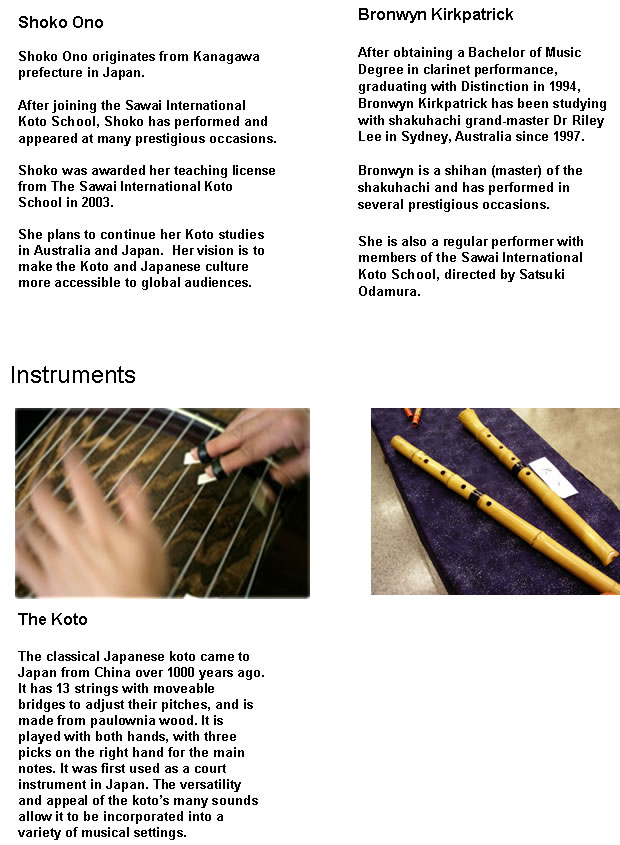How to collect tickets
The number of seats available at the both venue for this performances are limited. Therefore, it is strongly advised that reservations are made in advance. Please inform us by telephone number 3304644 or email: eojculture@connect.com.fj of your name and the numbers of seats required, by Friday, 20 November 2009. Your earlier bookings will be highly recommended due to high demand of reservations.You will be then provided a reservation confirmation number, which is required to be presented when collecting your tickets. Tickets can be collected at the Embassy of Japan (2nd Floor, Dominon House) by Wednesday, November 25 or at the each venue after 6 p.m. on the day of performance.
Only if there are still seats available, tickets may be obtained at the each venue after 6 p.m. on the day of performance.
PROGRAMME
1 絵夢 Emu – Picture Dream
Hideaki Kuribayashi – 1976
In this highly lyrical piece a series of simple motifs are established in each instrument in turn, to be varied infinitely in a subtle interplay of koto and shakuhachi. Hideaki Kuribayashi began studying the koto with Tadao Sawai in 1973. Today he is known as both a performer and composer of contemporary music for traditional Japanese instruments.
2 春の海 Haru no Umi – The Sea in Spring
Michio Miyagi – 1929“Haru no Umi” is one of Miyagi Michio's best known works, frequently heard in Japan at New Year. Composed in December 1929 as a duet for koto and shakuhachi, it depicts impressions gained on a springtime boat trip on the Inland Sea of Japan. Miyagi Michio (1894-1956) is considered to be the father of “shin nihon ongaku” (new Japanese music).
3 鶴の巣籠 Tsuru no Sugomori - Nesting of the CranesShakuhachi Solo - Traditional
“Tsuru no Sugumori” depicts the day in the life of a crane. Many fluttering techniques are employed to depict the bird in flight. The crane is revered in Japan for its elegance and parental affection and appears in many Japanese artworks.
4 サクラメンタによるキリシタンの子守唄 – Sacramental Christian Lullaby
Yoshiyuki Kōzu - 1980Sacramental Christian Lullaby was composed in memory of the early Japanese Christians who were persecuted by the military government before and during the Edo period (1600-1868).
5 さくら変奏曲 - Sakura Variations
Tadao Sawai - 1976
Koto Solo
This piece is a variation of the famous Japanese song "Sakura Sakura" which means "Cherry Blossoms".
6 Meda Dau Doka / God Bless Fiji - Fijian National Anthem
Michael Prescott – 1970
The Fijian National Anthem has been arranged for Koto and Shakuhachi.
7 萌春 hōshun – Breaking Spring
Katsutoshi Nagasawa –1971In this elegiac evocation of spring and new life, the sounds of nature are evoked in the idiomatic timbres of both Koto and Shakuhachi. At times, the sonorous chords of the koto underlie the pastoral sounds of shakuhachi; at others, the koto takes the lead.



